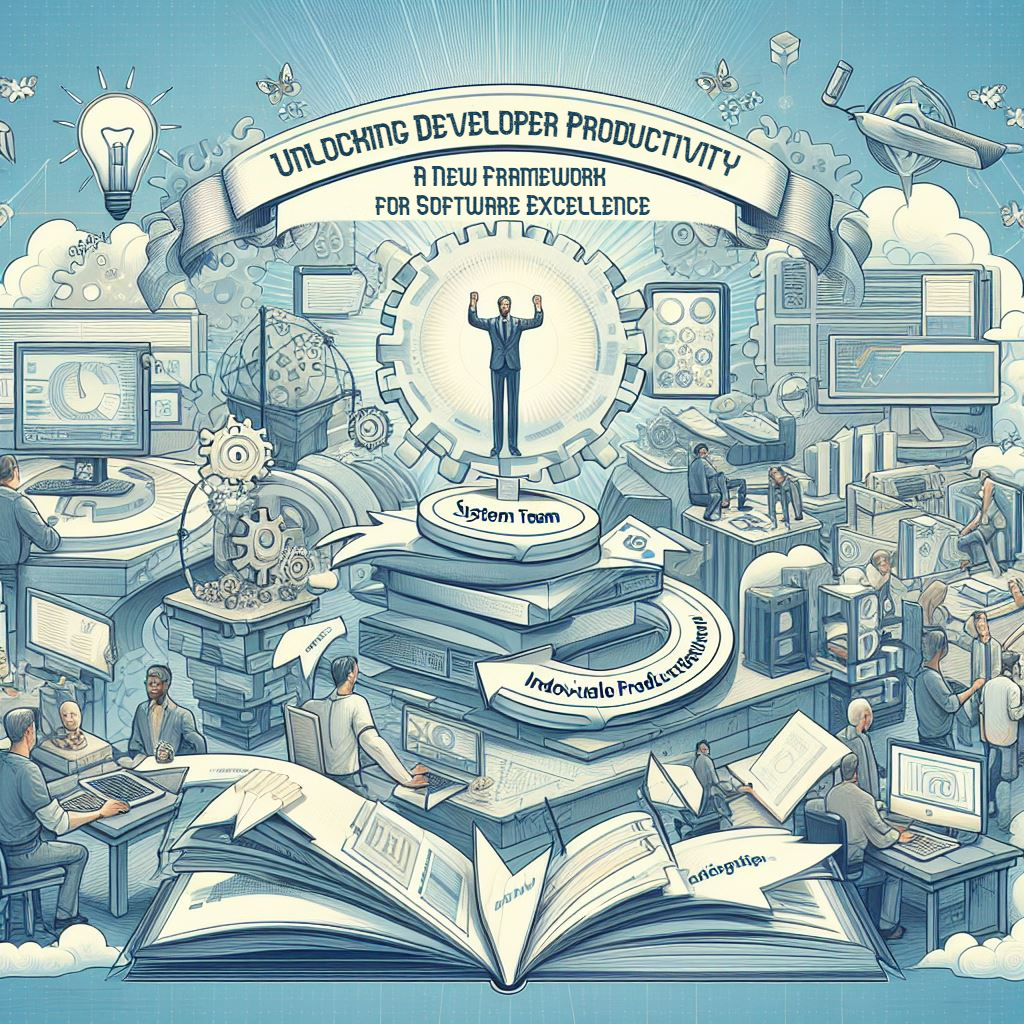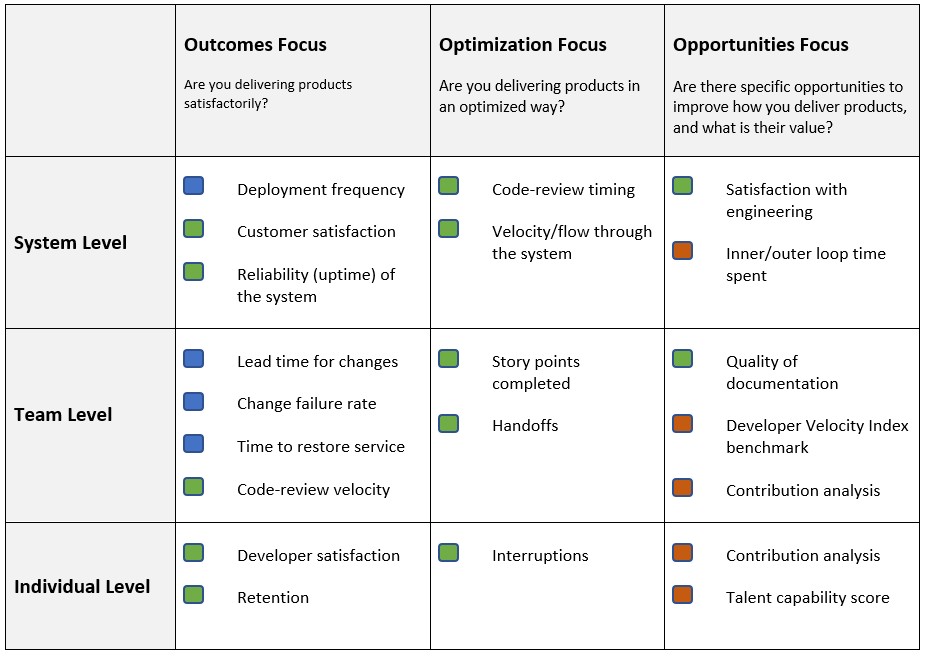Software development has long been plagued by the notion that productivity is too complex to measure. Yet today, with technology at the core of business, companies can no longer fly blind. They need visibility into how engineering capacity maps to strategic goals.
We approach that moves beyond tracking outputs like lines of code. Instead, it examines productivity through three integrated lenses—system, team, and individual—to reveal specific obstacles and opportunities. This provides actionable insights to help leaders address key questions, including:
- What organizational blockers prevent our developers from peak performance?
- Which capability gaps should be prioritized for upskilling?
- How can we ensure engineers maximize time spent on high-value coding?
Used correctly over time, these performance insights compound, leading to faster innovation cycles, higher quality, and better end user experiences.
Evolving Industry Perspectives
Long-held skepticism around measuring productivity has not aged well as software becomes essential infrastructure across sectors. Still, inertia persists from an outdated assumption that the link between inputs and outcomes lacks clarity compared to simpler functions like sales. The reality is that aspects of software development do remain slippery to quantify perfectly - it’s highly collaborative, iterative, and unpredictable. But the same could be said of many creative endeavors that ultimately must tie back to concrete organizational objectives. With the stakes so high and the war for talent so fierce, companies can no longer leave this critical lever unoptimized.
Thought leaders have stepped up with standards to track outputs and results, notably DORA metrics (link) from Google and SPACE metrics (link) from GitHub. These evaluate critical outcomes like deployment velocity and job satisfaction. While invaluable, they often require retroactive firefighting to pinpoint root causes when issues surface. The approach builds on these foundations by also assessing the inward workings of engineering machines—identifying hidden friction points before small problems snowball and perceptions curdle. The insights reveal where targeted improvements will have direct impact on strategic goals around quality, innovation pace, and productivity itself.

Examining Productivity Across Three Levels
Like assessing health, productivity tracking requires different vital signs and holistic triangulation. What’s informative to evaluate organ systems often diverges from tissues or individual cells. Software engineering is no different.
1. The System Level
First, we use system metrics to gauge overall development velocity and output quality relative to business priorities. This top-down viewpoint assesses questions like:
- How frequently are we releasing new features or fixes?
- How long do those changes take to progress from code to customer?
- How many defects leak through to users?
Low velocity, long lead times, and poor quality suggest friction at play. Peeling back those surface-level indicators prompts examining team structure, tools, and processes. For example, at one of the travel tech companies we cooperated with, releases happened just once quarterly. Developers burned cycles manually regression testing and resolving conflicts as multiple changes piled up. By shifting left on quality with test automation and moving to decentralized code ownership, they began releasing weekly with fewer bugs.
2. The Team Level
With a baseline established, we zoom in on the dynamics inside and across product teams that directly impact system outputs. Some examples of team-level metrics include:
- Benchmarking: Practices, structure, and maturity measured against peers
- Backlog analysis: Trends in work item progression, type, and source
- Hygiene metrics: Defect escape rates, technical debt, failed builds
Comparing teams against industry norms spots specific gaps ripe for process or tooling improvements. It also surfaces people's challenges like motivation and coordination issues between functions. A product company realized that their backlogs ballooned as collateral tasks snowballed from unstable foundations. Streamlining architecture review and tightening component contracts enabled more autonomous feature development.
3. The Individual Level
We examine productivity at the engineer level. Here the metrics explore skills, experience, time allocation and personal output:
- Capability assessments: Programming proficiency across key technologies
- Contribution analysis: Work item completion rates normalized by complexity
- Time apportionment: Coding versus meetings, management, manual testing
This granular visibility identifies strengths to leverage and developmental areas to shore up. It steers coaching, mentoring, and targeted training to where individuals and teams need it most. One of our clients, uncovered an over-reliance on a few highly proficient engineers who became structural bottlenecks. Building a larger mid-level cohort through internal mobility and upskilling increased productive throughput.
Putting Insights into Action
Driving real productivity gains requires translating observations into actions. But it also means sidestepping common pitfalls that can undermine developer motivation if programs are administered poorly. Focusing on opportunities related to software developer productivity metrics can provide clearer paths for improvement:


These metrics, developed by various sources including Gap Intelligence, GitHub, and Microsoft Research, focus on enhancing efficiency, flow, and overall software excellence, aligning with business performance objectives.
Linking Data to Decisions
With credible benchmarks in hand, engineering leaders can pinpoint barriers that impede developers from peak performance. Comparing teams often highlights where rethinking processes and technology investments will alleviate friction. At the individual level, the diagnostics guide capability building.
We work closely with our customers to interpret findings and shape initiatives that address the biggest leverage points revealed. A few examples that provide major lift:
- Optimizing CI/CD pipelines means developers spend less time on manual integration and testing. That translates to more high-value coding activity.
- Leveling up design review rigidity and architecture guidance accelerates autonomous decision making for developers later own.
- Providing self-service access to provisioned platform services avoids developers wasting cycles on infrastructure.
Undertaking too many changes simultaneously dilutes focus and makes it harder to validate impact. We encourage an agile approach to process improvement just as with software development. Double down on addressing the one or two most critical blockers revealed through productivity tracking.
Avoiding Measurement Mishaps
Many early industry attempts to quantify productivity failed due to perpendicular approaches like tracking commits or lines of code. When simplistic metrics tie directly to rewards or perceptions, developers invariably find ways to game the system. Productivity tracking should never happen in a vacuum or serve as a cudgel. Otherwise, it breeds resentment over surveillance and rewards activity over outcomes. For sustainable traction, developers must believe the time spent providing data pays dividends in their day-to-day experience and autonomy. The focus should stay on identifying obstacles to great work rather than strictly monitoring individuals.
With care and engagement, these insights unlock orchestrated improvements over time that compound. Developers spend fewer cycles battling bureaucracy and technical debt. More enterprising talents can concentrate on higher reasoning work like architecture and complex algorithm design rather than manual tasks. Combined, these shifts add up to accelerated innovation.
Accelerating Your Productivity Flywheel
Measuring productivity invites discovery of better ways to develop game-changing software. But it also requires executive buy-in and developer willingness to illuminate previously hidden blind spots. Working together, we can build an instrumentation and analytics foundation to surface insights. Our experts help interpret findings into an action plan for your business targeting quick returns on high-impact areas. And we provide ongoing support to monitor productivity velocities over time.
You understand that software sits at the crux of strategic differentiation today. Let us help quantify and unlock the potential of your human capital turning great ideas into reality. The future of technology leadership depends on raising visibility into what propels practitioner productivity and fulfillment upward over the long-term. The time to leap forward is now!
